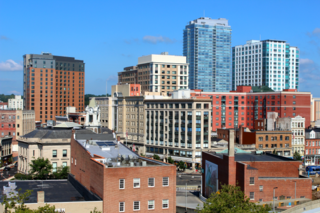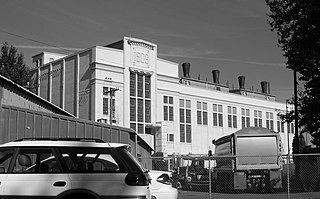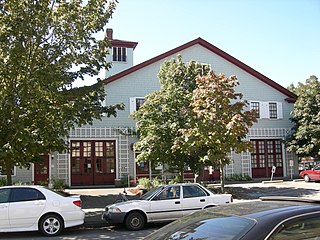
Georgetown is a historic neighborhood and commercial district in Northwest Washington, D.C., situated along the Potomac River. Founded in 1751 as part of the colonial-era Province of Maryland, Georgetown predated the establishment of Washington, D.C. by 40 years. Georgetown was an independent municipality until 1871 when the United States Congress created a new consolidated government for the entire District of Columbia. A separate act, passed in 1895, repealed Georgetown's remaining local ordinances and renamed Georgetown's streets to conform with those in Washington, D.C.

New York City Hall is the seat of New York City government, located at the center of City Hall Park in the Civic Center area of Lower Manhattan, between Broadway, Park Row, and Chambers Street. Constructed from 1803 to 1812, the building is the oldest city hall in the United States that still houses its original governmental functions. The building houses the office of the Mayor of New York City and the chambers of the New York City Council. While the Mayor's Office is in the building, the staff of thirteen municipal agencies under mayoral control are located in the nearby Manhattan Municipal Building, one of the largest government buildings in the world, with many others housed in various buildings in the immediate vicinity.

Pioneer Square is a neighborhood in the southwest corner of Downtown Seattle, Washington, US. It was once the heart of the city: Seattle's founders settled there in 1852, following a brief six-month settlement at Alki Point on the far side of Elliott Bay. The early structures in the neighborhood were mostly wooden, and nearly all burned in the Great Seattle Fire of 1889. By the end of 1890, dozens of brick and stone buildings had been erected in their stead; to this day, the architectural character of the neighborhood derives from these late 19th century buildings, mostly examples of Richardsonian Romanesque.

The West Point Light, also known as the Discovery Park Lighthouse, is an active aid to navigation on Seattle, Washington's West Point, which juts into Puget Sound and marks the northern extent of Elliott Bay. The lighthouse is similar in design to the Point No Point Light and was added to the National Register of Historic Places in 1977. It is a main feature of Seattle's Discovery Park.

Downtown Stamford, or Stamford Downtown, is the central business district of the city of Stamford, Connecticut, United States. It includes major retail establishments, a shopping mall, a university campus, the headquarters of major corporations and Fortune 500 companies, as well as other retail businesses, hotels, restaurants, offices, entertainment venues and high-rise apartment buildings.

The Embassy Gulf Service Station is a service station in Washington, D.C., located on P Street near Dupont Circle and at the entrance to the Georgetown neighborhood. Constructed in 1937, it was added to the National Register of Historic Places in 1993.

The Georgetown Steam Plant, located in the Georgetown neighborhood of Seattle, Washington, was constructed in 1906 for the Seattle Electric Company to provide power for Seattle, notably for streetcars.
Washington, D.C., is the capital city and federal district of the United States. Below is a list of Washington, D.C.-related articles.

There are 77 properties listed on the National Register of Historic Places in Albany, New York, United States. Six are additionally designated as National Historic Landmarks (NHLs), the most of any city in the state after New York City. Another 14 are historic districts, for which 20 of the listings are also contributing properties. Two properties, both buildings, that had been listed in the past but have since been demolished have been delisted; one building that is also no longer extant remains listed.

The Elks Temple in Tacoma, Washington is a historic Beaux Arts Fraternal building built in 1916 for the Fraternal Order of Elks, now housing the McMenamins Elks Temple hotel, restaurant and event space.

Washington Hall is a historic building and a registered city landmark in Seattle, Washington, that is listed on the National Register of Historic Places. It was originally built as a community center by the Danish Brotherhood in America, a fraternal organization, with meeting halls and one-room apartments for new immigrants. In 1973, the building was sold to the Sons of Haiti who leased the space to various tenants. It was purchased in 2009 by Historic Seattle and was renovated and re-opened in 2010 as an events and performance space.
Victor W. Voorhees (1876–1970) was an American architect most active in Seattle, Washington. He is credited with the design of over 110 building projects. Considered one of the Northwest's finest designer of garages, he was responsible for a large number of automobile related buildings built on Capitol Hill in the 1910s and 1920s, Seattle's original auto row. His residential plan book, Western Home Builder, which went through six editions between 1907 and 1911, provided templates for popular local house designs like the Seattle box.

The Old City Hall, also known as Oxford Flats, is located just north of downtown along a commercial corridor in Davenport, Iowa, United States. It was individually listed on the National Register of Historic Places in 1983. In 2020 it was included as a contributing property in the Davenport Downtown Commercial Historic District.

Everett City Hall is the name given to a building located in Everett, Washington listed on the National Register of Historic Places. The building originally served as the city hall when it was built in 1929; it was extensively renovated from 1977 to 1979, with the city renting the Roosevelt School from the Everett School District during that time. However, for all practical purposes, it no longer serves this role; the mayor's office and city administration were relocated to the nearby Wall Street Building, which the city bought in 1991 for $11.2 million, around 1993. The building is currently used by the police department and by the city council to hold public meetings.

The Church of the Blessed Sacrament is a Roman Catholic parish within the Archdiocese of Seattle serving Seattle's University District. It is the only parish in the archdiocese to be owned and operated by the Order of Preachers and is within the jurisdiction of the Western Dominican Province. The church's current prior is Fr. Augustine Hilander, and the current pastor is Fr. Dominic David Maichrowicz.

The architecture of Seattle, Washington, the largest city in the Pacific Northwest region of the U.S., features elements that predate the arrival of the area's first settlers of European ancestry in the mid-19th century, and has reflected and influenced numerous architectural styles over time. As of the early 21st century, a major construction boom continues to redefine the city's downtown area as well as neighborhoods such as Capitol Hill, Ballard and, perhaps most dramatically, South Lake Union.

The Georgetown Car Barn, historically known as the Capital Traction Company Union Station, is a building in the Georgetown neighborhood of Washington, D.C., in the United States. Designed by the architect Waddy Butler Wood, it was built between 1895 and 1897 by the Capital Traction Company as a union terminal for several Washington and Virginia streetcar lines. The adjacent Exorcist steps, later named after their appearance in William Friedkin's 1973 horror film The Exorcist, were built during the initial construction to connect M Street with Prospect Street.

The Wallingford Fire and Police Station, also known as the Wallingford Police Precinct Station, at 1629 N. 45th St. in Seattle, Washington was built in 1913. It was listed on the National Register of Historic Places in 1983.

Abraham Horace Albertson was an American architect who was one of Seattle, Washington's most prominent architects of the first half of the 20th century. He was born in New Jersey and educated at Columbia University in New York. Early in his career, he moved to Seattle in the employ of a well-known New York architectural firm with that was developing a large area in downtown. He worked on many projects in Seattle from around 1910 through the 20s and early 30s. Some of his designs are Seattle landmarks and/or listed on the National Register of Historic Places.




















